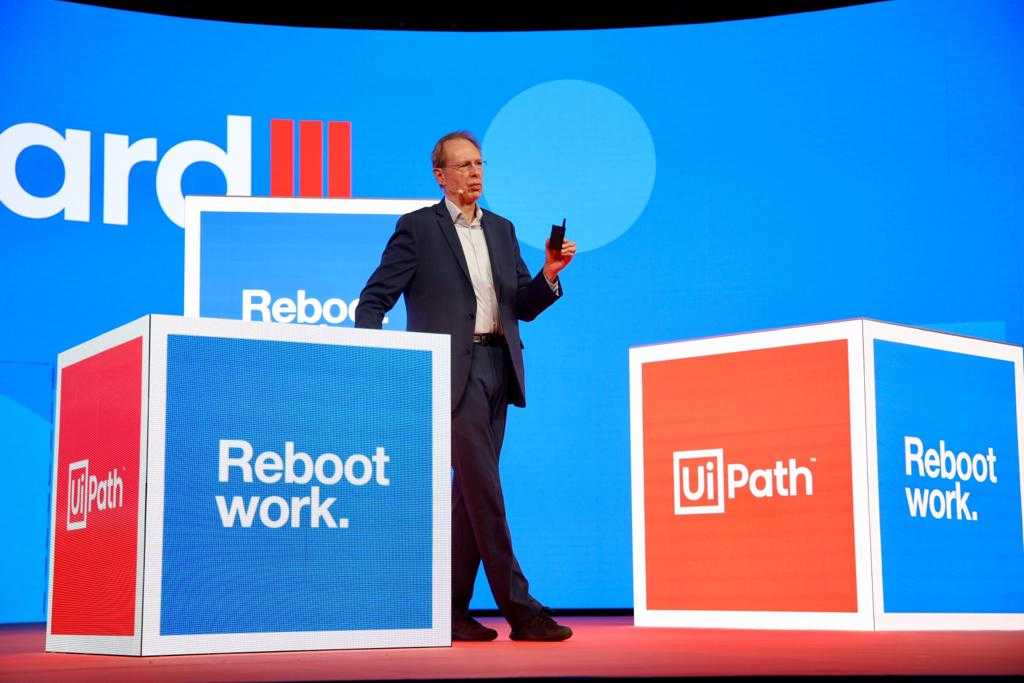 AI
AI
 AI
AI
 AI
AI
Predicting the future of robotic process automation was the theme of day two’s keynote at the UiPath Forward event in Las Vegas. On the stage were keynote speakers Guy Kirkwood, chief evangelist at UiPath Inc. and Craig Le Clair (pictured), vice president and principal analyst at Forrester Research Inc.
Giving his take on the keynote conversation was Dave Vellante, longtime analyst and host of theCUBE, SiliconANGLE Media’s mobile livestreaming studio. Vellante analyzed Kirkwood and Le Clair’s forecasts for the future of RPA and gave his own prognosis for the growth of the bot market, as well as a prediction for who will win the 2020 U.S. election (see the full interview with transcript here). (* Disclosure below.)
UiPath evangelist Kirkwood foresees a downturn in the global economy starting in 2020. However, he predicts that an economic slowdown will benefit the RPA market. “If there’s an economic downturn, people are going to want to get more for less,” Vellante explained.
One way to get more for less is to become more efficient and gain faster return on investment is through automation. “I don’t think it’s going to be falling off a cliff or disaster,” Vellante said. “I think it’s a healthy pullback.”
He agrees that this moderation will benefit RPA, which is gaining market share relative to other tech spending categories, but it could negatively affect low-wage workers doing mundane, repetitive tasks.
Although RPA providers assure us that it’s only positive for the workforce and current customers are generally happy about the benefits, Le Clair’s research tells a different story, predicting that 16% of jobs will be lost to RPA and other workplace task automation.
“You are going to see unquestionable job impacts from automation,” Vellante said. “Humans have always been replaced by machines, but for the first time in history we’re seeing cognitive functions replacing humans. And that’s going to have a big disruptive impact on the workforce.”
Economic downturn is only one of seven predictions made by Kirkwood in his keynote speech. The second was “RPA becoming a container for automation like YouTube is a container for video,” which Vellante dismissed as unlikely in the near future. “RPA is right now a back-office business-to-business function,” he said. “I think it will stay that way for a couple of years.”
Increased commonality between automations was Kirkwood’s third prediction. Vellante agreed. ”UiPath’s marketplace will allow sharing automations, and there will be commonality,” he said. “I think it’s critical for scale.”
As a father of college-age children, Vellante chuckled at Kirkwood’s prediction that students entering the workforce will be a factor for employers adopting RPA. “College kids don’t know what RPA is,” he said, giving a timeline of five to eight years before pressure from incoming employees influences workplace automation.
“We will continue to be surprised by the intelligence of machines and the stupidity of humans” is a prediction that Vellante agrees with wholeheartedly. The gap between man and machine is closing, he explained. He also agrees with Kirkwood’s statement that the United Nations will discuss the impact of automation on the workplace: “It’s already happening.”
Increased consolidation between RPA vendors and service vendors is Kirkwood’s seventh and final prediction. “You’re going to see one or two specialists emerge … and the number one player is going to make a lot of money, the No. 2 player is going to do OK, the No. 3 player is going to struggle, and everyone else is going to break even or bundle it in,“ Vellante said.
Before that happens, the market needs to mature with RPA crossing the chasm from back to front office and from simple mundane tasks to more complicated automations.
“It’s got to be able to deal with unstructured data,” he said. “It’s got to be able to handle attended bots where you’re injecting humans into the equation and you’re actually using machine learning and artificial intelligence to learn and then identify other areas of automation and actually have systems of agency that can act. I would predict those things are actually going to happen, because you’re going to see so much effort and money and emphasis put into AI for competitive advantage.”
Whether UiPath is going to be the winner remains to be seen, but Vellante gives the company a good chance. “All the bankers are hovering around,” he noted, ready to jump on an initial public offering he thinks is likely to come before long.
Here’s the complete video analysis, part of SiliconANGLE’s and theCUBE’s coverage of UiPath Forward. (* Disclosure: TheCUBE is a paid media partner for UiPath Forward. Neither UiPath, the sponsor for theCUBE’s event coverage, nor other sponsors have editorial control over content on theCUBE or SiliconANGLE.)
Support our mission to keep content open and free by engaging with theCUBE community. Join theCUBE’s Alumni Trust Network, where technology leaders connect, share intelligence and create opportunities.
Founded by tech visionaries John Furrier and Dave Vellante, SiliconANGLE Media has built a dynamic ecosystem of industry-leading digital media brands that reach 15+ million elite tech professionals. Our new proprietary theCUBE AI Video Cloud is breaking ground in audience interaction, leveraging theCUBEai.com neural network to help technology companies make data-driven decisions and stay at the forefront of industry conversations.